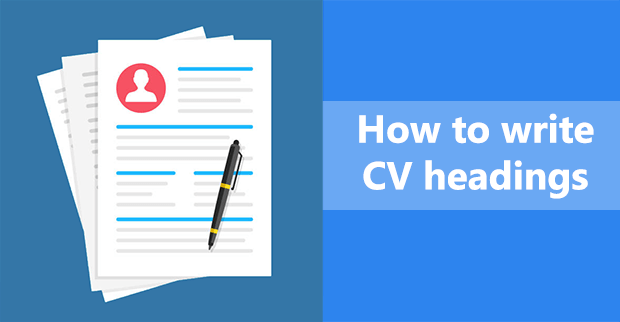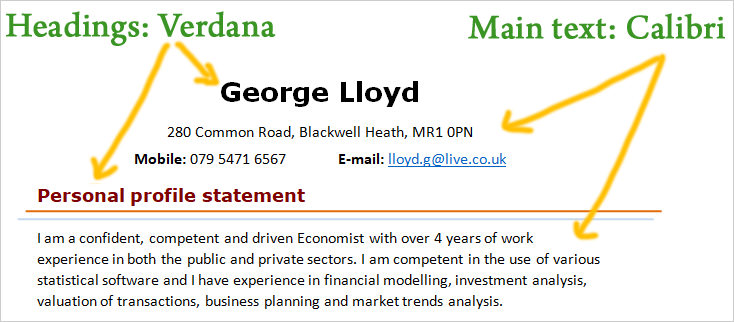 Sobhan Mohmand, Career Expert
Sobhan Mohmand, Career Expert  29 March 2023
29 March 2023

A CV heading is the top part of your CV and it is the first thing that employers will see when they review your document. A good CV heading consists of your name and contact details, without the inclusion of ‘Curriculum Vitae’ or ‘CV’ at the top.
One recruiter rightly commented, “Don’t state the obvious, we know it’s a ‘Curriculum Vitae’ so you don’t need to put it at the top of the document.”
Yes, your CV must have a header.
Just like all books require a title that explains what the book is about, a CV heading should instantly identify the owner of the document and how to contact them.
Headings and subheadings guide the reader through your document and help them find and absorb information effortlessly.
Let’s begin with how not to write a CV heading.
Over the years, applicants have written different things as the headings of their CVs. Some are good, some bad and others are just ugly!

This is a popular one.
Traditionally, CVs were always headed ‘Curriculum Vitae’ or ‘CV’ but this practice has become out of date in modern times, especially since the turn of the century.
Four reasons not to use ‘Curriculum Vitae’ as the header of your CV:
Blooper: One candidate couldn’t even get the spelling right and actually headed his CV ‘Kuriculam Vitay’! Needless to say, they weren’t invited for a job interview. (James Innes, The CV book, our definitive guide to writing the perfect CV, Pg.50).

“Confidential” is another heading that recruiters hate to see on CVs!
Recruiters are aware that a CV by its very nature will contain some sensitive or personal information so they are unlikely to pass on your CV to people not involved in the recruitment or candidate selection process.
Let’s face it; your CV probably does not contain top-secret or highly sensitive information about artificial intelligence projects or the Pentagon’s secret UFO programs.
It is just one among the many millions of other CVs that are being read and reviewed on a monthly basis during the recruitment process.
It should be assumed that employers treat everyone’s personal details with the utmost care, regardless of whether the documents are labelled “confidential” or not.
At the top of the first of your CV, put your full name. It should be in bold type, at a larger font size than the rest of the text and centred on the page to increase the impact.
Leave several lines of white space below this heading, before you list your personal details such as your address, telephone number and email address.
Consider below the CV header of Carlos Norris (NOT related to the legendary Chuck Norris):

What makes Carlos’s CV heading good?
It’s not necessary to use different fonts for the heading and main text of your CV, as long as you use other formatting techniques such as boldface and larger font size to contrast between the heading and main text.
The best fonts to use for your CV include Lucida Sans, Helvetica, Arial, Verdana, Cambria and Times New Roman. They are professional, mainstream and easy to read.
If you do decide to use a different font for your headings, your best bets are Verdana or Tahoma of the sans serif typeface families.
For example:

Besides the main heading of your CV, it also requires a number of subheadings for the different sections of the document.
A typical CV format consists of the following sections:
This section contains your name and contact details.
Your personal profile statement is a short statement that outlines your skills, abilities, education and work experience to date. It is an overview of what you can offer to the employer and their organisation.
The achievements section of your CV contains a list of your most important achievements that are relevant to do the job.
You can include a lot of accomplishments in this section, including awards, promotions, excellent grades, increased sales or productivity, etc.
The education section is a summary of your educational background to date. All entries should be in chronological order (i.e. most recent entries first).
You may put this section before or after the work experience section, it depends entirely on where you are in your career for which job you are applying for. As a rule of thumb, place the education section before the employment section if you do not have a lot of relevant work experience.
The work experience section should contain all the relevant work experience that you have to date. This may include work in full-time, part-time, permanent, temporary, paid, unpaid, placements and internships positions.
You can also label this CV subheading as “Employment” or “Employment history.”
The qualifications section contains a list of your qualifications, particularly those that are relevant to the job.
The qualifications section is sometimes combined with the education section. There is no right or wrong way of doing this. You may completely remove this subheading and combine it with the education section with the heading:
“Education and qualifications”
The skills and abilities section is located on the second page of your CV and contains a brief list of your key skills, abilities and competencies.
Examples of skills that you can include in this section are:
You can use the hobbies and interests section of your CV to demonstrate that you’re a well-rounded person who is engaged in extracurricular activities and in the community.
The references section should be the last subheading of your CV.
You can either write the complete contact details of your two referees, or you can simply write: “References are available upon request.”
Both methods are acceptable.
A CV heading is the main thing that a recruiter will see when they review your CV. It should consist of your name – written in large, bold letters and centred on the page – followed by your contact details. It should not be headed ‘CV’, ‘Curriculum Vitae’, ‘résumé or anything else as it’s obvious what the document is.
Furthermore, your CV is made up of different sections so you also need to write subheadings for each of them to make it easier for recruiters to find and absorb key information. You may use boldface and other simple design features to enhance the visual presentation of your CV and make it stand out from the crowd.
Good luck with your job search!